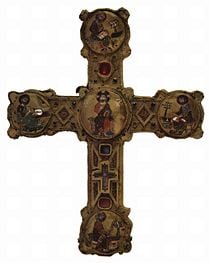Difference between revisions of "Cross" - New World Encyclopedia
Scott Dunbar (talk | contribs) m |
({{Contracted}}) |
||
| Line 1: | Line 1: | ||
| − | {{Claimed}}{{Started}} | + | {{Claimed}}{{Started}}{{Contracted}} |
[[Image:Meister des Reliquienkreuzes von Cosenza 002.jpg|thumb|right|210px|A reliquary in the form of an ornate Christian Cross]] | [[Image:Meister des Reliquienkreuzes von Cosenza 002.jpg|thumb|right|210px|A reliquary in the form of an ornate Christian Cross]] | ||
Revision as of 16:01, 15 October 2007
In general terms, a cross is a geometrical figure consisting of two bars that run perpendicular to each other. These bars usually go vertically and horizontally, for if they run diagonally (e.g. "X") then the design is technically termed a saltire.
Found in many cultures and religions, the cross is an ancient human symbol most closely connected with the religion of Christianity, where it is seen as a representation of the crucifixion of Jesus. During the period of the Roman Empire, criminals and dissenters were hung on crosses in public places to inspire fear of authority and respect for law and order. Thus, the cross was a Roman symbol of capital punishment. Believeing that Jesus had died on the cross for humanitys' sins, the early Christians transfomed the symbol of the cross into a sign of God's love, grace and ultimate salvation. In this mannner, the meaning of the cross metamorphasized into something positive. Nevertheless, it remained a disturbing symbol for some due to its horrible associations with criminality, death and capital pubishment.
Even though the cross is the most well known symbol of Christianity, there are many varieties of crosses within the Christian world (see below). For example, the cross used in Eastern Orthodoxy is distinct from the Roman Catholic crucifix, which is a cross that includes a representation of Jesus' body on it. In Christian theology, the cross symbolizes not only the crucifixion but also agape (self-sacrificing love). The vertical and horizontal dimensions of the cross also represent the two most important teachings of Jesus: that one should love of God (represented by the vertical dimension of the cross) and also love one's neighbour (represented by the horizontal dimesnion in the community).[1]
Nevertheless, despite its sublime theological meaning, it remains a fact that the Christian cross still evokes mixed reactions in the world today, and continues to be interpreted in different ways. It should not be forgotten that the cross has negative assocaitions among certain groups, who associate it with violence and imperialism. The cross often evokes memories of the crusades against the Muslims, racism by the Klu Klux Clan, and aggressive missionizing in many parts of the world.
Etymology
The word cross was introduced to English in the 10th century as the term for the instrument of the torturous execution of Christ (gr. stauros', xy'lon), gradually replacing rood, ultimately from Latin crux, via Old Irish cros. Originally, both 'rood' and 'crux' referred simply to any "pole," the later shape associated with the term being based on church tradition, rather than etymology. The word can nowadays refer to the geometrical shape unrelated to its Christian significance from the 15th century. crux in latin means cross, and it was a roman devise of torture where they nailed any person to a wooden cross, an act called crucifying, and let them die of exposure or starvation/dehydration while hanging from the cross. the cross is now the symbol of the roman catholic church which is ironic because it is bassically the symbol of torture and death, although some call it a a reminder of christs martyrdom.
History of use of the symbol
It is not known when the first cross image was made; after circles, crosses are one of the first symbols drawn by children of all cultures. There are many cross-shaped incisions in European cult caves, dating back to the earliest stages of human cultural development in the stone age. Like other symbols from this period, their use continued in the Celtic cultures in Europe. For example, celtic coins minted many centuries before the Christian era may have an entire side showing this type of cross, sometimes with the five cardinal points marked by concave depressions in the same style as in stoneage carvings. Other coins may be showing the cross held by a rider on a horse and springing forth a fern leaf, sometimes identified as a Tree of Life symbol.
The cross-shaped sign, represented in its simplest form by a crossing of two lines at right angles, greatly antedates, in both East and West, the introduction of Christianity. It goes back to a very remote period of human civilization. It is supposed to have been used not just for its ornamental value, but also with religious significance.[2]
Some have sought to attach to the widespread use of this sign, in particular in its swastika form, a real ethnographic importance. It may have represented the apparatus used in kindling fire, and thus as the symbol of sacred fire (Burnouf, La science des religions) or as a symbol of the sun,[3] denoting its daily rotation. It has also been interpreted as the mystic representation of lightning or of the god of the tempest, and even the emblem of the Aryan pantheon and the primitive Aryan civilization.
Another symbol that has been connected with the cross is the ansated cross (ankh or crux ansata) of the ancient Egyptians, which often appears as a symbolic sign in the hands of the goddess Sekhet, and appears as a hieroglyphic sign of life or of the living.[4] In later times the Egyptian Christians (Copts), attracted by its form, and perhaps by its symbolism, adopted it as the emblem of the cross (Gayet, "Les monuments coptes du Musée de Boulaq" in "Mémoires de le mission française du Caire", VIII, fasc. III, 1889, p. 18, pl. XXXI-XXXII and LXX-LXXI).
The 5th-century B.C.E. tombs at Naqsh-e Rustam, Iran, are carved into the cliffside in the shape of a cross. They are known as the "Persian crosses".
In the Bronze Age we meet in different parts of Europe a more accurate representation of the cross, as conceived in Christian art, and in this shape it was soon widely diffused. This more precise characterization coincides with a corresponding general change in customs and beliefs. The cross is now met with, in various forms, on many objects: fibulas, cinctures, earthenware fragments, and on the bottom of drinking vessels. De Mortillet is of opinion that such use of the sign was not merely ornamental, but rather a symbol of consecration, especially in the case of objects pertaining to burial. In the proto-Etruscan cemetery of Golasecca every tomb has a vase with a cross engraved on it. True crosses of more or less artistic design have been found in Tiryns, at Mycenæ, in Crete, and on a fibula from Vulci..
Christian use
During the first two centuries of Christianity, the cross may have been rare in Christian iconography, as it depicts a purposely painful and gruesome method of public execution. The Ichthys, or fish symbol, was used by early Christians. The Chi-Rho monogram, which was adopted by Constantine I in the fourth century as his banner (see labarum), was another Early Christian symbol of wide use.
However, the cross symbol was already associated with Christians in the second century, as is indicated in the anti-Christian arguments cited in the Octavius of Minucius Felix, chapters IX and XXIX, written at the end of that century or the beginning of the next,[5] and by the fact that by the early third century the cross had become so closely associated with Christ that Clement of Alexandria, who died between 211 and 216, could without fear of ambiguity use the phrase τὸ κυριακὸν σημεῖον (the Lord's sign) to mean the cross, when he repeated the idea, current as early as the Epistle of Barnabas, that the number 318 (in Greek numerals, ΤΙΗ) in Genesis 14:14 was a foreshadowing (a "type") of the cross (T, an upright with crossbar, standing for 300) and of Jesus (ΙΗ, the first two letter of his name ΙΗΣΟΥΣ, standing for 18),[6] and his contemporary Tertullian could designate the body of Christian believers as crucis religiosi, i.e. "devotees of the Cross".[7] In his book De Corona, written in 204, Tertullian tells how it was already a tradition for Christians to trace repeatedly on their foreheads the sign of the cross.[8]
The Jewish Encyclopedia says:
- The cross as a Christian symbol or "seal" came into use at least as early as the second century (see "Apost. Const." iii. 17; Epistle of Barnabas, xi.-xii.; Justin, "Apologia," i. 55-60; "Dial. cum Tryph." 85-97); and the marking of a cross upon the forehead and the chest was regarded as a talisman against the powers of demons (Tertullian, "De Corona," iii.; Cyprian, "Testimonies," xi. 21-22; Lactantius, "Divinæ Institutiones," iv. 27, and elsewhere). Accordingly the Christian Fathers had to defend themselves, as early as the second century, against the charge of being worshipers of the cross, as may be learned from Tertullian, "Apologia," xii., xvii., and Minucius Felix, "Octavius," xxix. Christians used to swear by the power of the cross (see Apocalypse of Mary, viii., in James, "Texts and Studies," iii. 118).
- See also: True Cross
In Christendom the cross reminds Christians of God's act of love and atonement in Christ's sacrifice at Calvary - "the Lamb of God who takes away the sin of the world." The cross also reminds Christians of Jesus' victory over sin and death, since it is believed that through His death and resurrection He conquered death itself.
Roman Catholic, Eastern Orthodox, Oriental Orthodox, some Anglican, and other Christians often make the sign of the cross upon themselves. This was already a common Christian practice in the time of Tertullian.[9] One of the twelve great feasts in the Eastern Orthodox Church is the Exaltation of the Cross on September 14, which commemorates the consecration of the basilica on the site where the (allegedly) original cross of Jesus was discovered in 326 by Helena of Constantinople, mother of Constantine the Great. The Catholic Church celebrates the feast on the same day and under the same name ("In Exaltatione Sanctae Crucis"), though in English it has been called the feast of the Triumph of the Cross. Roman Catholic, Eastern Orthodox and Anglican bishops place a cross [+] before the name when signing a document.
Jehovah's Witnesses, noting the pre-Christian use of the cross symbol and disputing its early use by Christians (see above), reject it as essentially pagan in origin. They hold that the "cross" on which Jesus died was really a single-beamed "stake".
Crosses are a prominent feature of Christian cemeteries, either carved on gravestones or as sculpted stelas. Because of this, planting small crosses is sometimes used in countries of Christian culture to mark the site of fatal accidents, or to protest alleged deaths.
In Catholic countries, crosses are often erected on the peaks of prominent mountains, such as the Zugspitze or Mount Royal, so as to be visible over the entire surrounding area.
Forms of the Cross
The cross is often shown in different shapes and sizes, in many different styles. It may be used in personal jewelry, or used on top of church buildings. It is shown both empty, and with the body of Christ (corpus) nailed to it, in which case it is typically called a crucifix, though this word, in its original sense, denotes the body affixed to the cross. Roman Catholic and High Anglican depictions of the cross are often crucifixes, in order to emphasize Jesus' sacrifice. Many Protestant traditions depict the cross without the corpus, interpreting this form as an indication of belief in the resurrection rather than as representing the interval between the death and the resurrection of Jesus.
Forms of the Christian cross include:
- Altar cross. Cross on a flat base to rest upon the altar of a church. Earliest known example is a picture in a manuscript from the 9th century; by the 10th century they were commonly used, but the earliest extant altar cross is from the 12th century located at Great Lavra on Mt. Athos.
- Calvary cross. Either a stepped cross (see below), or a Gothic-style cross mounted on a base shaped to resemble Mt. Golgatha (where Christ was crucified), with the Virgin Mary and Saint John on either the base or crossarms.
- Canterbury cross. A cross with four arms of equal length which widen to a hammer shape at the outside ends. Each arm has a triangular panel inscribed in a triquetra (three-cornered knot) pattern. There is a small square panel in the center of the cross. A symbol of the Anglican and Episcopal Churches.
- Consecration cross. One of 12 crosses painted on the walls of a church to mark where it had been anointed during its consecration.
- Crux fourchette. A cross with flared or forked ends (see illustration at Crosses in Heraldry).
- Crux gemmata. A cross inlaid with gems. Denotes a glorification of the cross, this form was inspired by the cult of the cross that arose after Saint Helena's discovery of the true cross in Jerusalem in 327.
- Crux hasta. A cross with a long descending arm; a cross-staff.
- Crux pattée. A Greek cross with flared ends.
- Double cross. A cross with two crossbars. The upper one is shorter, representing the plaque nailed to Jesus' cross, Also known as a crux gemina. Also called the Cross of Lorraine.
- Gammadion. A hooked cross or swastika, also known as a crux gammata.
- Globus cruciger. Globe cross. An orb surmounted by a cross; used in royal regalia.
- Greek cross. With arms of equal length. One of the most common Christian forms, in common use by the 4th century.
- Gnostic cross. Cross used by the early Gnostic sects.
- Latin cross. With a longer descending arm. Along with the Greek cross, it is the most common form, it represents the cross of Jesus' crucifixion.
- Living cross. One of two possibilities: Either a natural cross made of living vines and branches. Or, a man-made cross with vines or plants planted at its base. In the all-natural version, it refers to the legend that Jesus' cross was made from the Tree of Life. In the man-made cross with plants planted at the base, it contrasts the "new" Tree of Life (the cross) with the Genesis Tree of Life. In both cases it shows Jesus' death (the cross) as a redemption for original sin (Tree of Life).
- Lorraine cross. Once with crossbars of equal length near the top and the bottom, now practically identical with the patriarchal cross
- Maltese cross. A Greek cross with arms that taper into the center. The outer ends may be forked.
- Marian Cross. A term invented to refer to Pope John Paul II's combination of a Latin cross and the letter M, representing the Mary present on Calvary.
- Occitan cross
- Papal Cross. A cross with three bars near the top. The bar are of unequal length, each one shorter than the one below.
- Patriarchal cross. A double cross, with the two bars near the top, the upper shorter than the lower. Also called an archiepiscopal cross. The Eastern Orthodox cross adds a slanted bar near the foot.
- Pectoral cross. A large cross worn in front of the chest (in Latin, pectus) by some clergy.
- Peter cross. A cross with the crossbeam placed near the foot, that is associated with Saint Peter because of the tradition that he was crucified with head down. In modern times it has been used also as a symbol of the Devil and Satanism.
- Saltire or crux decussata. An X-shaped cross associated with St. Andrew, patron of Scotland, and so a national symbol of that country. The shape is that of the cross on which Saint Andrew is said to have been martyred. Also known as St. Andrew's Cross or Andrew Cross.
- Stepped cross. A cross resting on a base with three steps, also called a graded or a Calvary cross.
- Suppedaneum cross. Also known as Crux Orthodoxa, Byzantine cross, Eastern cross, Russian cross, Slavic or Slavonic cross. A three-barred cross in which the short top bar represents the inscription over Jesus' head, and the lowest (usually slanting) short bar, placed near the foot, represents his footrest (in Latin, suppedaneum). This cross existed very early in Byzantium, and was adopted by the Russian Orthodox Church and especially popularized in the Slavic countries.
- Tau cross. A T-shaped cross. Also called the Saint Anthony's cross and crux commissa.
The Dagger symbol also represents the Christian cross. In Unicode, it is U+2020(†).
| Cross Name | Description | Picture |
|---|---|---|
| Ankh |
Also known as the Key of the Nile, the Looped Tau Cross, and the Ansated Cross. It was an Ancient Egyptian symbol of life. Sometimes given a Latin name if it appears in specifically Christian contexts, such as the crux ansata ("handled cross"). Shaped like the letter T surmounted by an oval or circle. Originally the Egyptian symbol for "life", it was adopted by the Copts (Egyptian Christians). Also called a crux ansata, meaning "cross with a handle". |

|
| Canterbury cross |
Used in the Anglican Churches. It has four arms of equal length, each widening at the outer end in a hammer shape so that their rims form a near circle. Each arm bears a triangular panel incised with a triquetra symbolizing the Trinity. In the center of the cross is a small square. The Saxon original dates from c. 850 C.E. and was excavated in 1867 in Canterbury, England. A stone replica can be found in Canterbury Cathedral and in several other Anglican cathedrals around the world. [1] [2] |
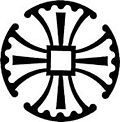
|
| Christian cross |
Also known as the Latin cross or crux ordinaria. It is the most common symbol of Christianity, intended to represent the redeeming martyrdom of Jesus when he was crucified on the True Cross in the New Testament. |

|
| Coptic Cross |
A small circle from which emanate four arms of equal length, with angled T shapes in the corner, cross-pieces outward, representing the nails used in Jesus' crucifixion. This cross receives its name from Coptic Christianity, which centered around Alexandria, Egypt. |
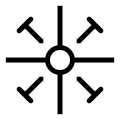
|
| Original Coptic Cross |
The original Coptic cross used by early Gnostic Christians in Egypt. |

|
| Coptic ankh |
The Coptic ankh is the Ankh related pre Original Coptic cross of the early Gnostic Christians in Egypt. |

|
| Greek cross |
Also known as the crux immissa quadrata. Has all arms of equal length. |
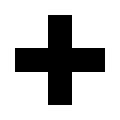
|
| Eastern cross |
Used in the Eastern Orthodox Church. The top line is said to represent the headboard, and the bottom, slanted line represents the footrest, wrenched loose by Jesus' writhing in intense agony. The letters IC XC found at the end of the main arm of most Eastern Orthodox Crosses are a Christogram, representing the name of Jesus Christ. |
85px |
| High cross |
Free-standing Celtic crosses commonly found in Ireland and to a lesser extent in Great Britain, very common in churches and graveyards. |

|
| St. Brigid's Cross |
This cross is found throughout Ireland. It is told that the cross was made by Brigid, daughter of a Pagan King from reeds to be used as an instrument of conversion. However, Brigid's name is derived from Brigit (also spelled Brigid, Brìghde, Brìde, and Bríde), a Celtic Goddess of fire, poetry, and smithcraft, and today the cross is used to protect houses from fire. This is an example of the integration of religious traditions. The cross itself derives from the Indo-European Swastika, or Solar Wheel |
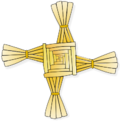
|
| Labarum |
Constantine I's Labarum is also known as a Chrismon, Chi-Rho (from the two Greek letters that make it up) or monogram of the name Jesus Christ. Several other forms of Chrismons exist. |
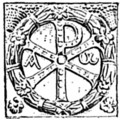
|
| Lebanese Forces Cross |
Inspired from the eastern crosses, it symbolizes three things:
|

|
| Lorraine Cross |
Used in heraldry. It is similar to a patriarchal cross, but usually has one bar near the bottom and one near the top, rather than having both near the top. Is part of the heraldic arms of Lorraine in eastern France. It was originally held to be a symbol of Joan of Arc, renowned for her perseverance against foreign invaders of France. |
75px |
| Marian Cross |
Etched on the casket of Pope John Paul II, the Marian Cross is a Catholic adaptation of the traditional Latin cross to emphasize Catholic devotion to Mary. |

|
| Nordic Cross |
Used in flags descended from the Dannebrog. |

|
| Occitan cross |
Based on the counts of Toulouse's traditional coat of arms, it soon became the symbol of Occitania as a whole. |

|
| Papal Cross |
The three cross-bars represent the Roman Catholic Pope's triple role as Bishop of Rome, Patriarch of the West, and successor of St. Peter, Chief of the Apostles. |

|
| Patriarchal cross |
Similar to a traditional Christian cross, but with an additional, smaller crossbar above the main one meant to represent all the Orthodox Christian Archbishops and Patriarchs. In the Eastern Orthodox Church, this cross is sometimes seen with an additional, slanted bar near the foot of the cross (see Byzantine Cross). This cross is similar to the Lorraine Cross and the Caravaca Cross. |

|
| Presbyterian Cross |
Used by Presbyterian denominations. |

|
| Red Cross |
Used as a symbol for medical care in most of the world, the Red Crescent being used in Islamic countries and the Magen David Adom in Israel. |

|
| Cross of Sacrifice |
A Latin cross with a superimposed sword, blade down. It is a symbol used by the Commonwealth War Graves Commission at the site of many war memorials. |

|
| Royal Flag of Georgia |
Used in Georgia as national flag, first used by Georgian King Vakhtang Gorgasali in the 5th century and later adopted by Queen Tamar of Georgia in the 13th century. The flag depicts a Jerusalem cross, adopted during the reign of George V of Georgia who drove out the Mongols from Georgia in 1334. |

|
| St. Nino's Cross |
Also known as a "Grapevine cross" and traditionally ascribed to Saint Nino, the 4th-century female baptizer of the Georgians, it is used as a symbol of the Georgian Orthodox Church. |

|
| Saint Andrew's Cross |
Used in Scotland's national flag and the naval ensign of the Russian Navy, it is also called the Saltire, the Boundary Cross (because it was used by the Romans as a barrier) and the crux decussata. Saint Andrew is believed to have suffered a martyr's death on such a cross, hence its name. The cross does not have to be at this particular angle to qualify as a saltire; the symbol X can also be considered a St. Andrew's Cross. |

|
| St George's Cross |
Used in England's national flag. |

|
| Saint Peter's Cross |
An upside-down Latin cross, based on a tradition that holds that Saint Peter was martyred by being crucified upside-down. Today it is often associated with anti-Christian or Satanic groups and some heavy metal artists, such as King Diamond. |

|
| Skull and crossbones |
Not a cross as such, but a saltire made of bones, with an overlaid skull. While traditionally associated with pirates, it was actually relatively rarely used by them, each ship having its own design, often involving an hourglass. |

|
| Sun cross |
Also known as the Sunwheel, solar cross or Odin's cross, because Odin's symbol in Norse mythology was a cross in a circle. Used throughout Native American culture to represent the great Medicine Wheel of life. |

|
| Tau Cross |
Also known as Saint Anthony's Cross, the Egyptian Cross and the crux commissa. It is shaped like the letter T. Francis of Assisi used it as his signature. |

|
| Thieves' Cross |
Also known as the Furka Cross. The fork, shaped like the letter Y. [3] |
|
| Mariner's Cross |
The Mariner's Cross is a stylized cross in the shape of an anchor. The Mariner's Cross is also referred to as St. Clement's Cross in reference to the way he was martyred. |

|
| Order of Christ Cross |
Cross originally used by the Portuguese Order of Christ. Since then it has become a symbol of Portugal, used on the sails of the carracks during the Discoveries Era, and currently by the Portuguese Air Force. |
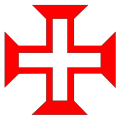
|
In heraldry
These crosses are ones used exclusively or primarily in heraldry, and do not necessarily have any special meanings commonly associated with them. Crosses that are used in heraldry but also commonly in other contexts are not listed here.
| Cross name | Description | Picture |
|---|---|---|
| The cross as heraldic "ordinary" |
A simple heraldic cross (the default if there are no additional specifying words) has arms of roughly equal length, artistically proportioned to the particular shape of the shield, which extend to the edges of the shield. Illustrated is the blazon "Azure, a cross Or" (i.e. a gold cross on a blue shield). A cross which does not extend to the edges of the shield is humetty, in heraldic terminology. |
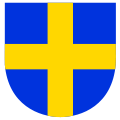
|
| Cross anchry |
A stylized cross in the shape of an anchor. Also known as the anchored cross or mariner's cross. |

|
| Cross barbée |
Also known as the cross barby or arrow cross, this symbol consists of two double-ended arrows in a cross configuration. Best known today for its use by the fascist Arrow Cross Party in the 1930s, the symbol actually dates to ancient times and was used by Hungarian tribes in the Middle Ages. In Christian use, the ends of this cross resemble the barbs of fish hooks, or fish spears. This alludes to the Ichthys symbol of Christ, and is suggestive of the "fishers of men" theme in the Gospel. |

|
| Cross bottony |
A cross with the ends of the arms bottony (or botonny), i.e. shaped like an architectural trefoil. It occurs counterchanged on the flag of Maryland. |

|
| Cross cercelée |
A cross which, opening at the ends, turns round both ways, like a ram's horns. |
120px |
| Cross crosslet |
A cross with the ends of each arm crossed. |

|
| Crusaders' cross |
Also known as the Jerusalem cross. This cross was the symbol of the Crusader Kingdom of Jerusalem, which existed for almost two hundred years after the First Crusade. The four smaller crosses are said to symbolize either the four books of the Gospel or the four directions in which the Word of Christ spread from Jerusalem. Alternately, all five crosses can symbolize the five wounds of Christ during the Passion. This symbol is also used in the flag of Georgia. |
120px |
| Cross flory |
A cross with the ends of the arms flory (or fleury), having a shape like a fleur-de-lys. |

|
| Cross fourchee |
One form of the heraldic cross fourchee (fourchée, fourchy) or cross fourche (meaning "forked"). |

|
| Cross fylfot |
Upright cross with truncated bent arms |
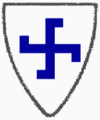
|
| Jerusalem cross |
A variant of the Crusaders' cross with cross potent. It is also the logo for the Knights and Dames of the Holy Sepulcher of Jerusalem. |

|
| Maltese cross |
With arms which narrow towards the center, and are indented at the ends. The "eight-pointed cross" (with no curved lines). |
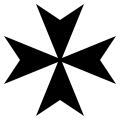
|
| Cross moline |
In a cross moline, the ends of the arms are split and curved back. |

|
| Cross patonce |
A cross patonce is more or less intermediate between a cross pattée and a cross flory (or fleury). |

|
| Cross pattée |
A cross pattee (pattée, patty) has arms narrowing towards the centre, but with non-indented ends. See also Iron Cross. |

|
| Cross pommee |
A cross pommee (pommée, pommy) has a circular knob at the end of each arm. |

|
| Cross potent |
This cross has a crossbar at the end of each of its arms. "Potent" is an old word for a crutch, and is used in heraldic terminology to describe a T shape. |

|
| Quadrate |
A cross with a square at the intersection point. |

|
| Cross triple parted and fretted |
In heraldry, a "cross triple parted and fretted" (or "treble parted and fretted") is interlaced. Here, a version which is "Or on an Azure field" (gold on blue) is shown. |
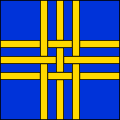
|
| Cross voided |
A "cross voided throughout", also known as the Gammadia, can be seen as a Greek cross with its centre lines removed, or as composed of four angles (L shapes) separated by a thin space. So the name "gammadia" refers to its being made up of four shapes similar to a capital Greek letter gamma; the word gammadion can also refer to a swastika. |

|
| Cross of St James |
The Cross of St. James,, similar to a Cross Flory Fitch, is formed by a Cross Flory, where the lower part is fashioned as a sword blade (fitched)—making this a cross of a warrior. It is most frequently depicted in red. (The version depicted here is the one used by the order of Santiago.) |
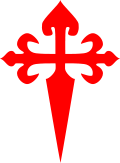
|
There are numerous other variations on the cross in heraldry. See heraldry for background information.
The semi-classic book A Glossary of Terms Used in Heraldry by James Parker (1894) is online, and contains much information about variants of crosses used in heraldry.
Other Symbolic Uses
Written crosses are used for many different purposes, particularly in mathematics.
- The Roman numeral for ten is X.
- In the Latin alphabet, the letter X and the minuscule form of t are crosses.
- The Chinese character for ten is 十; (see Chinese numerals).
- The dagger or obelus (†)
- The addition (or plus) sign (+) and the multiplication (or times) sign (×).
- If n≥1 is an integer, the numbers coprime to n, taken modulo n, form a group with multiplication as operation; it is written as (Z/nZ)× or Zn*.
A cross is often used as a check mark because it can be clearer, easier to create with an ordinary pen or pencil, and less obscuring of the text or image that is already present than a large dot. It also allows marking a position more accurately than a large dot.
A large cross through a text often means that it is wrong or should be considered deleted.
In flags
Several flags have crosses, including all the nations of Scandinavia, whose crosses are known as Scandinavian crosses, and many nations in the Southern Hemisphere, which incorporate the Southern Cross. The Flag of Switzerland since the 17th century has displayed an equilateral cross in a square (the only square flag of a sovereign state apart from the Flag of the Vatican City); the Red Cross emblem was based on the Swiss flag. The flag of Georgia displays a red Jerusalem cross, and can also be described as a St George cross accompanied by four crosslets.
Notes
- ↑ Huston Smith.
- ↑ "Various objects, dating from periods long anterior to the Christian era, have been found, marked with crosses of different designs, in almost every part of the old world. India, Syria, Persia and Egypt have all yielded numberless examples . . . The use of the cross as a religious symbol in pre-Christian times and among non-Christian peoples may probably be regarded as almost universal, and in very many cases it was connected with some form of nature worship" (Encyclopaedia Britannica (1946), Vol. 6, p. 753.
- ↑ Bertrand, La religion des Gaulois, p. 159; and cf. "These crosses were used as symbols of the Babylonian sun-god, [See book], and are first seen on a coin of Julius Caear, 100-44 B.C.E., and then on a coin struck by Caear’s heir (Augustus), 20 B.C.E. On the coins of Constantine the most frequent symbol is [See book]; but the same symbol is used without the surrounding circle, and with the four equal arms vertical and horizontal; and this was the symbol specially venerated as the ‘Solar Wheel’. It should be stated that Constantine was a sun-god worshipper, and would not enter the ‘Church’ till some quarter of a century after the legend of his having seen such a cross in the heavens" The Companion Bible, Appendix No. 162
- ↑ "The cross in the form of the ‘Crux Ansata’ . . . was carried in the hands of the Egyptian priests and Pontiff kings as the symbol of their authority as priests of the Sun god and was called ‘the Sign of Life.’"(The Worship of the Dead (London, 1904), by Colonel J. Garnier, p. 226.
- ↑ Minucius Felix speaks of the cross of Jesus in its familiar form, likening it to objects with a crossbeam or to a man with arms outstretched in prayer (Octavius of Minucius Felix, chapter XXIX).
- ↑ Stromata, book VI, chapter XI
- ↑ Apology., chapter xvi. In this chapter and elsewhere in the same book, Tertullian clearly distinguishes between a cross and a stake.
- ↑ "At every forward step and movement, at every going in and out, when we put on our clothes and shoes, when we bathe, when we sit at table, when we light the lamps, on couch, on seat, in all the ordinary actions of daily life, we trace upon the forehead the sign" (De Corona, chapter 3)
- ↑ De Corona, chapter 3, written in 204.
ReferencesISBN links support NWE through referral fees
- Koch, Rudolf (1955). The Book of Signs. Dover, NY. ISBN 0-486-20162-7.
- Webber, F. R. (1927, rev 1938). Church Symbolism: an explanation of the more important symbols of the Old and New Testament, the primitive, the mediaeval and the modern church. Cleveland, OH. OCLC 236708.
External links
- "Archæology of the Cross and Crucifix" in the 1913 Catholic Encyclopedia
- Articles on The Cross
- An Explanation of the Russian Orthodox Three-Bar Cross
- Archæology of the Cross and Crucifix
- The Cross and Crucifix in Liturgy
- Variations of Crosses - Images and Meanings
- Crucifixion in Antiquity Information on the methods of crucifixion used by the Romans
- MSN Encarta article
- Columbia Encyclopedia article
- Variations of Crosses - Images and Meanings
- Information about Crosses (Seiyaku.com)
- www.christiansymbols.net 22 pages of images and meanings.
- Extensive reference and images of crosses
Credits
New World Encyclopedia writers and editors rewrote and completed the Wikipedia article in accordance with New World Encyclopedia standards. This article abides by terms of the Creative Commons CC-by-sa 3.0 License (CC-by-sa), which may be used and disseminated with proper attribution. Credit is due under the terms of this license that can reference both the New World Encyclopedia contributors and the selfless volunteer contributors of the Wikimedia Foundation. To cite this article click here for a list of acceptable citing formats.The history of earlier contributions by wikipedians is accessible to researchers here:
The history of this article since it was imported to New World Encyclopedia:
Note: Some restrictions may apply to use of individual images which are separately licensed.
